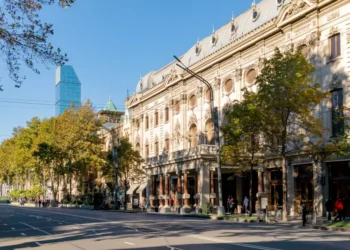In an era when globalization threatens to flatten cultural nuance, India stands as a striking exception. Its identity is not built on uniformity, but on harmony in diversity: spiritual, linguistic, culinary, artistic. This is a country where centuries-old traditions coexist with cutting-edge technology, where sacred chants echo through digital speakers, and where rituals adapt without losing their soul.
To understand the heartbeat of this cultural dynamism, we sat down with Darispan Prasher, chairman of Cultural Diversity for a Peaceful Future, an NGO working to preserve India’s intangible heritage in a rapidly modernizing world. In his words, India is “not only the cultural wealth of its own population, but also a spiritual experience shared with the world.”
But what gives India its cultural resilience? How does it carry ancient wisdom into the future without nostalgia or fossilization? And what does it really mean to say, as Indian philosophy often does, “Vasudhaiva Kutumbakam” the world is one family?
Yoga and Meditation as The Soul of a Civilization
When asked what best captures the essence of Indian culture, Prasher doesn’t reach for mythology, dance, or food, though all of these are deeply embedded in the Indian consciousness. Instead, he starts with something more inward: yoga and meditation.
“They’re not just practices,” he says. “They are bridges, between body and spirit, between action and reflection, between India and the world.”
What makes these traditions remarkable is their radical openness. Unlike many cultural expressions that are rooted in a particular faith or community, yoga and meditation invite participation from anyone. They aren’t exclusive to Hindus, Buddhists, or Jains; nor are they confined to Indians.
“These are gifts India has offered not to claim, but to share,” Prasher explains. “And the world has responded. Today, yoga is practiced in over 190 countries. Yet in India, its relevance is still intimate, it shapes how people breathe, think, and move through daily life.”
The point, Prasher emphasizes, is not just the techniques, but the philosophy they carry. In a world obsessed with speed, yoga and meditation whisper of stillness. In a society fractured by divisions, they speak of wholeness. They are a living embodiment of India’s oldest civilizational wisdom: that balance, not dominance is the true power.
A Civilization of Coexistence
India’s cultural DNA is built on coexistence, not just tolerance. This is a land where Hinduism, Buddhism, Jainism, and Sikhism were born, and where Islam, Christianity, Judaism, and Zoroastrianism found not just refuge but respect. It’s not an easy pluralism, it is constantly being negotiated, but it is real.
Prasher points to how this diversity is reflected in India’s most cherished traditions.
“Our festivals, architecture, even the food we eat all are mosaics,” he says.
Walk through any Indian city and this mosaic reveals itself. A church bell rings next to the call to prayer from a mosque. Hindu temples stand beside Sikh gurdwaras and Buddhist viharas. No other country celebrates Diwali and Eid, Christmas and Buddha Purnima with equal public joy.
Even India’s built environment tells this story. The carved temples of Khajuraho, the serene Buddhist stupas of Sanchi, the shimmering Golden Temple in Amritsar, the Mughal gardens and domes of Delhi and Agra, and the Portuguese churches of Goa, all these are not relics. They are living spaces, still used, still revered.
Underlying it all is a set of shared values that transcend any one religion: ahimsa (non-violence), seva (service), karma, and sarva dharma sambhava (equal respect for all paths). These aren’t just philosophical ideals, they inform how people treat each other, how communities function, how daily life is shaped.
“India doesn’t erase difference,” says Prasher. “It cultivates it. That’s why its culture is so rich.”
Languages as Living Cultures
No discussion of Indian culture is complete without understanding its linguistic landscape. While many countries grow uneasy with multilingualism, India thrives in it. With 22 official languages and over 1,600 dialects, the country doesn’t just speak, it sings in multiple tongues.
“Each language is a cultural world in itself,” says Prasher. “You can’t understand Bengali without Tagore. You can’t grasp Tamil without its Sangam poetry. Punjabi is inseparable from its Sufi music. Gujarati carries Gandhi’s thoughts. Urdu gives voice to longing. Sanskrit encodes ancient philosophy.”
India’s oral traditions, its folk songs, storytelling forms, village theatre are often preserved through local dialects that may not appear in textbooks but live vibrantly in the hearts of millions. Even as Hindi and English dominate media and commerce, regional languages remain emotionally and artistically powerful.
This multilingualism isn’t chaotic, it’s layered. Children may grow up speaking a regional language at home, learn Hindi at school, and use English professionally. Far from erasing identities, this layering allows them to inhabit multiple cultural selves with ease.
Independence Day
Each year on August 15, India celebrates the hard-won freedom from colonial rule. But for Prasher, Independence Day is not just a national holiday, it is a reminder of India’s moral responsibility to honor its pluralistic soul.
“It’s a day to remember the sacrifices, yes,” he says. “But also a moment of collective affirmation, that no matter our religion or language, we belong to a shared project called India.”
The celebration is both grand and local. In Delhi, the Prime Minister hoists the flag at the Red Fort. Across towns and villages, schoolchildren perform patriotic songs and dances. Streets are filled with the colors of the Indian flag. What makes it moving is not the spectacle, but the sense of shared ownership, that freedom is not a trophy on a shelf, but a responsibility handed down.

How Ancient Traditions Evolve
India has never been a civilization afraid of change. Unlike many cultures that respond to modernity with defensiveness, India has absorbed it, reinterpreted it, and fused it with its heritage.
“Preservation here is not about freezing things in time,” Prasher says. “It’s about transmission.”
He points to how classical dance forms like Bharatanatyam and Kathak are being taught online. Ancient texts in Sanskrit, Tamil, Pali, and Persian are now digitized and accessible to global audiences. Artisans in remote villages use Instagram to showcase handloom sarees. Religious ceremonies are livestreamed; traditional music is trending on streaming platforms.
Even rituals have adapted. Urban Indians now celebrate festivals in eco-conscious ways, avoiding firecrackers during Diwali or using natural colors during Holi. Weddings blend ancient rites with modern logistics. The sacred and the contemporary are not seen as opposites, but as partners.
What this shows is that Indian tradition is not rigid, it is resilient. It bends without breaking.
The Role of Youth
For all his admiration of the past, Prasher insists that culture must move forward and it is India’s youth who are doing that work.
“Young people today are not just passive inheritors,” he says. “They’re curators, reformers, storytellers.”
They are reviving handloom industries through startups. They’re remixing folk music with electronic beats.
They question patriarchal customs while keeping the soul of tradition alive. They celebrate festivals not out of obligation but as expressions of identity. Importantly, they’re using digital tools to democratize access to culture, making knowledge that was once confined to temples or elite homes available to anyone with a smartphone.
For Prasher, this is the future of Indian culture: not nostalgic, not reactionary, but expansive, ethical, and alive.
A Global Message
In a world increasingly divided by race, religion, and nationalism, India’s ancient idea of Vasudhaiva Kutumbakam offers a radically inclusive vision. It does not ask others to become like India. It invites them to belong to something bigger.
Yoga may be India’s most visible gift to the world, but its most powerful export, Prasher believes, is its philosophy of shared humanity.
“Culture isn’t about pride,” he says. “It’s about participation. India shows that you can have deep roots and still reach out. You can honor the past without denying the present. And you can be one people, not by being the same, but by choosing to live together.”
By Kesaria Katcharava














